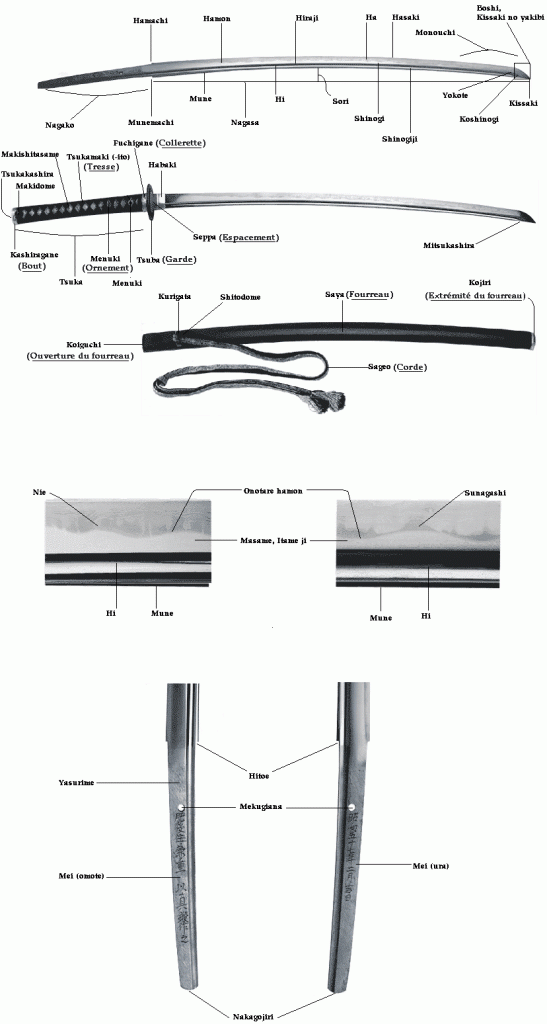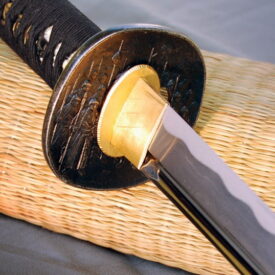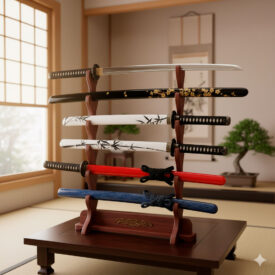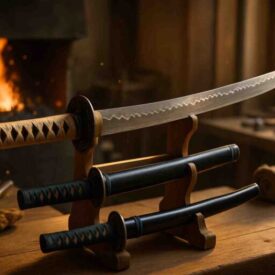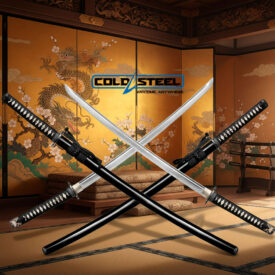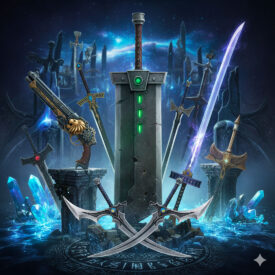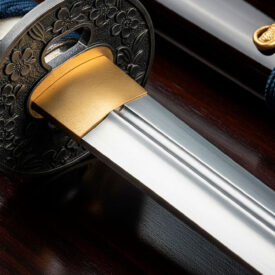Legend has it that in every blade the memory of its forger is kept: a katana is not only steel; it is a metallic poem, an architecture of balance and function where each piece has a defined purpose. Do you want to understand which parts make up a katana, how they influence its handling and why every detail matters? This article guides you, with rigor and passion, through the most important katana parts and their history, from the curvature of the edge to the braided silk of the handle.
At a glance: the essential parts of the katana
The katana is made up of three main groups: the blade (the cutting soul), the tsuka (the hilt that creates the bond between warrior and steel) and the saya (the scabbard that protects and conceals). Between them, a series of smaller parts — habaki, tsuba, seppa, mekugi — ensure the integrity and balance of the whole. Below you will find a detailed guide that breaks down each component and its practical and aesthetic function.
| Main Part | Japanese Name | Description |
|---|---|---|
| Blade Parts (Ken/To) | ||
| Blade length | Nagasa (長さ) | The length of the blade, measured from the Munemachi notch to the tip of the Kissaki. |
| Curvature | Sori (反り) | The curvature of the blade, fundamental to cutting ability and appearance. |
| Edge | Ha (刃) or Hasaki (刃先) | The tempered, extremely sharp cutting edge of the blade. |
| Spine | Mune (棟) | The spine or unsharpened rear part of the blade, opposite the edge. |
| Ridge line | Shinogi (鎬) | The ridge line that runs along the side of the blade. |
| Blade surface (above the Shinogi) | Shinogi-ji (鎬地) | The flat surface of the blade above the Shinogi, which is blunter. |
| Blade surface (between Shinogi and Hamon) | Hiraji (平地) or Hira (平) | The blade surface between the Shinogi and the temper line (Hamon). |
| Temper pattern | Hamon (刃文) | The wavy pattern or temper line visible along the edge. |
| Longitudinal groove | Bo‑Hi (棒樋) or Hi (樋) | A groove carved into the blade to lighten it and improve balance. |
| Tip line | Yokote (横手) | A distinctive line that separates the tip (Kissaki) from the rest of the blade. |
| Blade tip | Kissaki (切先) | The sharp, fan‑shaped tip of the blade. |
| Tip temper line | Bōshi (帽子) | The portion of the hamon that extends over the tip of the blade (Kissaki). |
| Edge curve at the tip | Fukura (脹) | The curve of the edge in the Kissaki area. |
| Cutting area | Mono‑Uchi (ものうち) | The cutting area of the blade, roughly 9 cm from the Kissaki. |
| Tang | Nakago (茎) | The narrow, unpolished extension of the blade that fits into the handle. |
| Forger’s signature | Mei (銘) | The forger’s signature engraved on the Nakago. |
| Peg hole | Mekugi Ana (目釘穴) | Holes in the Nakago to secure the blade to the handle. |
| Notch on the edge | Hamachi (刃区) | The notch on the edge that separates the blade from the Nakago. |
| Notch on the spine | Munemachi (棟区) | The notch on the spine that separates the blade from the Nakago. |
| Blade material | Jigane (地鉄) | General term for the blade material. |
| Steel surface pattern | Jihada (地肌) | The visible pattern of the steel, resulting from folding during forging. |
| Handle Parts (Tsuka) | ||
| Ray skin | Same (鮫) | Ray skin that covers the wooden core of the Tsuka, providing grip. |
| Braided cord | Tsuka‑ito (柄糸) | Braided cord that wraps the handle, adding grip and appearance. |
| Cord knot | Maki‑dome | The decorative and functional knot at the end of the Tsuka‑ito. |
| Decorative pieces | Menuki (目貫) | Small decorative metal pieces embedded under the Tsuka‑ito. |
| Pegs | Mekugi (目釘) | Pegs that pass through the Tsuka and Nakago to secure the blade. |
| Metal collar | Fuchi (縁) | A metal collar at the base of the handle, just before the guard. |
| Pommel | Kashira (頭) or Tsuka‑gashira (柄頭) | The pommel or metal piece that caps the end of the Tsuka. |
| Scabbard Parts (Saya) | ||
| Scabbard mouth | Koiguchi (鯉口) | The mouth of the Saya, where the blade is inserted. |
| Retaining cord | Sageo (下げ緒) | A cotton or silk cord tied to the Saya to secure the katana. |
| Ring for the Sageo | Kurigata (栗形) | A small raised ring on the Saya where the Sageo is tied. |
| Metal pieces on the Kurigata | Shito‑Dome (鵐目) | Decorative metal pieces fixed to the Kurigata. |
| Scabbard end | Kojiri (小尻) | The end of the Saya, opposite the Koiguchi. |
| Storage scabbard type | Shirasaya | A plain wooden mount used for storage. |
| Union and Decorative Components | ||
| Blade collar | Habaki (ハバキ) | A metal piece that secures the blade inside the Saya. |
| Metal spacers | Seppa (切羽) | Spacers on each side of the Tsuba to ensure a perfect fit. |
| Guard | Tsuba (鍔) | The circular guard that protects the hand and balances the sword. |
| Tsuba Parts | ||
| Central hole | Nakago ana | The central hole of the Tsuba through which the Nakago passes. |
| Area around the hole | Seppa dai | The area around the Nakago ana. |
| Hole for the kogai | Kogai hitsu ana | Hole in the Tsuba for a kogai (spike). |
| Hole for the small knife | Kozuka hitsu ana | Hole in the Tsuba for a small knife (Kozuka). |
| Blade area near the Tsuba | Tsuba Moto | The area of the blade near the Tsuba. |
The blade: anatomy, geometry and key terms
The blade is the technical heart of the katana. Here steel microstructures, differential tempering and a geometric design combine to determine cutting behavior and strength. Understanding its vocabulary will allow you to distinguish a piece by its function and its aesthetics.
- Nagasa: usable blade length, generally between 60 and 80 cm in traditional katanas; it influences reach and balance.
- Sori: blade curvature; a more pronounced sori facilitates curved cuts and quick draws.
- Ha (or Hasaki): the cutting edge; this is where the hamon, the temper line, is seen.
- Mune: the spine of the blade; its profile provides rigidity.
- Shinogi and Shinogi‑ji: the ridge (shinogi) and the surface between it and the spine (shinogi‑ji) define the blade’s cross section.
- Kissaki: the tip; its shape determines thrusting ability and the finishing geometry (bōshi and fukura).
- Hamon: the temper pattern, result of differential tempering; it is both functional and decorative.
- Hi (bo‑hi): a longitudinal groove that lightens the blade and alters its sound when swung.
- Nakago: the unpolished tang that inserts into the tsuka; the swordsmith often leaves his mei (signature) on it.
Comparative table: blade parts and their function
| Part | Japanese name | Function | Material/notes |
|---|---|---|---|
| Edge | Ha / Hasaki | Cutting | Tempered steel; precision of the temper profile |
| Curvature | Sori | Optimizes cutting and drawing | Result of differential tempering |
| Spine | Mune | Structural rigidity | Can be rounded or ridged |
| Tip | Kissaki | Thrust and cutting finish | Includes yokote and bōshi |
| Groove | Hi / Bo‑Hi | Lightens and modifies balance/sound | Can be decorative or functional |
| Tang | Nakago | Attachment to the handle | Usually bears the mei |
The tsuka: grip, control and symbolism
The handle is not a mere grip: it is the interface between the practitioner and the blade. Its construction combines wood, skin, cord and metal to offer grip, durability and aesthetics. Each layer has a purpose.
- Tsuka: wooden core that supports the structure.
- Same / Samegawa: ray or shark skin applied over the wood; it prevents slipping and distributes stresses.
- Tsuka‑ito: braiding worked over the samegawa; its pattern and material affect feel and appearance.
- Menuki: ornamental pieces placed under the tsuka‑ito; often symbolic and useful for hand positioning.
- Fuchi and Kashira: the metal collar and pommel that frame the tsuka and seal the braiding.
- Mekugi and Mekugi‑ana: pegs and holes that secure the tsuka to the nakago; essential for structural safety.
Practical details to understand the tsuka
The type of tsuka‑ito (silk, cotton, leather or synthetic) and the braid pattern will influence how the sword feels in hand. A tighter braid provides a firmer grip in combat, while looser variants yield a more ornamental finish.
Union and protection elements: habaki, tsuba and seppa
These seemingly small components play a vital role in the weapon’s stability and safety. The habaki seats the blade in the saya; the tsuba protects the hand and balances; the seppa adjust tensions and prevent play.
- Habaki: wedge‑shaped piece located at the base of the blade; it prevents lateral movement and ensures a firm fit.
- Tsuba: the guard that protects the hand; it can be simple or richly decorated, and its weight affects balance.
- Seppa: metal washers that adjust the assembly between tsuba and tsuka; they act as small shock absorbers.
Saya and external accessories
The saya is not a simple tube: its finish, weight and fit to the blade determine the ease of drawing and edge preservation. In addition, elements like the koiguchi, the kurikata and the sageo complete its functionality.
- Saya: scabbard, usually made of light, lacquered wood to protect the blade.
- Koiguchi: reinforced mouth of the saya, often made or finished in horn or metal.
- Kurikata: small projection where the sageo is tied.
- Sageo: cord used to secure the saya to the wearer’s belt or for ceremonial use.
- Kojiri: lower end of the saya; protects the tip and serves as a decorative finish.
How do the parts influence cutting performance?
A katana’s effectiveness does not depend solely on the steel but on the harmony between its parts. Length and sori define the optimal technique. The hamon and the temper profile determine edge hardness and core flexibility. The tsuba and habaki, in turn, influence static and dynamic balance.
- A katana with pronounced sori favors semicircular cuts and quick drawing.
- A visible hamon indicates differential tempering: hard edge and flexible core to absorb impacts.
- A well‑fitted nakago and solid mekugi ensure the sword stays intact under intense use.
Technical table: blade profiles and their advantages
| Profile | Description | Advantages |
|---|---|---|
| Shinogi‑zukuri | Section with a ridge (shinogi) and a flat between the ridge and the spine. | Ideal balance between rigidity and edge; common in combat katanas. |
| High Sori | Marked curvature of the blade. | Better for curved cuts and iaijutsu techniques. |
| Hi or bo‑hi | Longitudinal groove in the blade. | Reduces weight, improves balance and produces a distinctive sound when wielded. |
Catalog and replicas: models, mounting and accessories
Katana replicas seek to reproduce aesthetics and mounting. In some models elements such as samegawa or a visual hamon are preserved, although materials may vary. Understanding the parts will help you identify a shirasaya mounting, a traditional tsuka or a worked saya.
Types of mounting
- Traditional mounting: tsuka with samegawa, tsuka‑ito, tsuba and lacquered saya; suitable for collectors and practitioners of traditional martial arts.
- Shirasaya: smooth wooden mounting for storage; protects the blade but is not suitable for combat.
- Modern mounting: may use synthetic substitutes for tsuka‑ito or saya; intended for display or recreational practice.
Maintenance and conservation considerations
A well‑cared for katana ages with dignity; an abandoned one corrodes and loses the history it holds. Traditional maintenance includes cleaning with clove oil, removing dust from the nakago and storing in the saya at controlled humidity. Avoid practices that damage the temper or cause unnecessary scratches on the blade.
- Wipe the blade with a soft cloth and specific oil after each handling.
- Check the mekugi and the tsuka fit regularly.
- Avoid striking hard metals that can produce micro‑cracks in the edge.
Common mistakes when identifying parts
Many confuse mune with shinogi or indiscriminately call any handle end “kashira.” Knowing the terminology allows you to assess authenticity, mounting and finish quality.
- Do not confuse nakago (tang) with the visible part of the blade: the nakago is unpolished and usually bears the mei.
- An authentic hamon is the result of tempering; a “painted” hamon does not provide the structural properties of differential tempering.
- A very light tsuba may be ornamental but alter the sword’s balance.
Quick table: confusing terms and how to tell them apart
| Term | Meaning | How to check |
|---|---|---|
| Mune vs Shinogi | Mune is the spine; shinogi is the ridge. | Observe the blade’s cross section: the ridge separates two planes. |
| Real hamon vs decorative hamon | Real: temper line; decorative: engraving or paint. | Look for continuity and texture; a real hamon appears in the steel profile after polishing. |
| Authentic samegawa vs synthetic | Real ray skin vs plastic imitation. | The texture of small bumps (tiny dots) indicates authentic skin. |
How to read a katana: signs of the swordsmith
The mei on the nakago, the quality of the polish and mounting choices tell the story of who made it and what it was designed for. A signed nakago, a personalized tsuba or a distinct hamon indicate intentional craftsmanship.
- A legible mei on the nakago can indicate a school or maker; compare styles to identify periods and workshops.
- The finish of the nakago (patina) reveals age and maintenance.
- The selection of the tsuba and menuki often reflects the wearer’s personality.
Summary of key points and final reflection
The katana is a sum of parts where technique, aesthetics and symbolism meet. From the blade’s geometry to the details of the tsuka‑ito, each element influences performance and the story the sword tells. Knowing the katana parts lets you recognize quality, understand design decisions and appreciate the tradition behind each mounting.
If you look at a blade against the light you’ll see more than metal: you’ll see a map of decisions, the forger’s mark and a legacy that survives with each edge. Keep that knowledge and let the next katana you examine tell you its true story.

